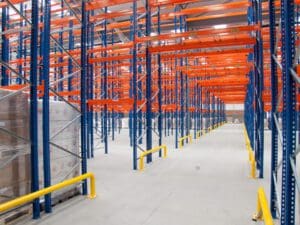
Advanced Handling & Storage Ltd
The Pallet Racking People

The growth of c-commerce and online retail, has it seems, surpassed all expectations over the last 15 years. The everyday consumer has quickly become accustomed to the ever increasing developments in technology, and subsequently, the ability to purchase items online and receive them, delivered to their doorstep within a matter of days. The easier it becomes for the consumer to purchase an item, and the more companies seem to be able to offer, the more we seems to expect.
Consequently, modernised logistics processes and retail markets are now rapidly evolving based on ecommerce purchasing behaviour; with online retail being the prominent driving force.
Through the UK with our ever-busy lives, online consumerism is a market which has expanded greatly, and is predicted to continue to grow. But with the goal of ecommerce items being delivered as fast as possible, what are companies having to do, to ensure the consumer always received their product, when and where they expect? The solution is termed ‘last mile delivery’.
Last mile delivery is defined as the movement of goods from a hub to the final destination. This specific type of delivery serves the purpose of delivering consumer goods across the ‘last leg’ of the logistics journey (typically to a personal residence), as fast as possible. It is this development of online consumerism and fragmentation of delivery options including click and collect points, and home deliveries, which has led to the increased demand for directly delivered goods and services.
The ‘Last Mile’ is a complex operation, and often the least efficient method of delivery within the supply chain.
Contributing to approximately 28% of the total transportation costs, last mile delivery experiences an intricate combination of issues involving cost, transparency, efficiency and streamlining. It also encounters physical challenges posed by overcrowded inner-city routes, whilst still aiming to deliver to the end destination on time.
With this in mind, as more businesses go online, there will be more parcels to deliver. The increase in online purchasing behaviour, has created a growing demand for the generation of the last-mile deliver fulfilment facilities, and as the shift from physical stores to ecommerce continues, the difficulties of managing the last mile delivery will also continue to grow.

In cities this equates to an increase in the need for freight transporting goods, and an overall requirement for additional warehousing space. This growth in economic activity, has left the supply chain competing with growing cities’ demands for transport and warehouse space, and ultimately has been required to adapt and accommodate logistical limitations including but not limited to diminishing stock room capacity, just-in-time replenishments and an increase in frequency of shop deliveries.
Previously it was estimated that by 2017, 10% of all retail purchases would be made online; more recently Barclays supported figures which show that the surge in online shopping is expected to generate more than 1.35 billion deliveries a year by 2018.
With the requirement for last mile delivery expected to grow, it is easy to see how ecommerce logistics is impacting upon our supply chain, and will continue to do so unless new solutions are introduced. Often, last mile delivery addresses are located in congested urban areas, thus new ideas have been implemented, to begin to overcome the many hurdles of urbanised last mile logistics.
One solution already enrolled in many parts of the UK is click and collect points in stores. This solution helps to consolidate multiple single home deliveries to a single point. Another is parcel lockers. Used widely by Amazon, again the aim is to deliver many items to one single collection point, which the consumer can walk or drive to; whilst more recently, mobile technology with GPS is being used in an effort to boost efficiency in city logistics. All of these solutions have the potential to resolve the current persistent issues of inefficiency, and high costs involved in ecommerce and last mile delivery; and going forwards, it is predicted that drones and autonomous ground vehicles with lockers, will soon be a viable solution for this final mile.
One thing that is for certain, is new customer expectations regarding time for delivery overall delivery experience and transparency of order progress, will force online retailers to invest in new technological solutions to manage their delivery operations, if they have not yet done so already.
From speed, to increased expectations for the delivery experience, to the increase of last mile delivery is unavoidable. We need to adapt our logistics processes, considering the best locations for sites to ideally be suited, to satisfy demand. It is imperative, we recognise that dealing with these challenges requires investment in a solution that helps businesses manage the transparency, efficiency, cost of speed of their deliveries, not just for now but for the future.Pallet Racking
Call Advanced Handling & Storage
If you are looking to maximise your warehouse to contribute to the futureproofing of your business, please don’t hesitate to get in touch with us on 01388 779111 or please send an email to [email protected]
Make sure you follow #TeamAdvanced on Social media for all our latest news and offers!
Like us on Facebook
Follow us on Twitter
Connect with us on LinkedIn
Subscribe to Our YouTube channel
Follow us on GooglePlus
Read our other blogs on Medium
Follow us on Instagram